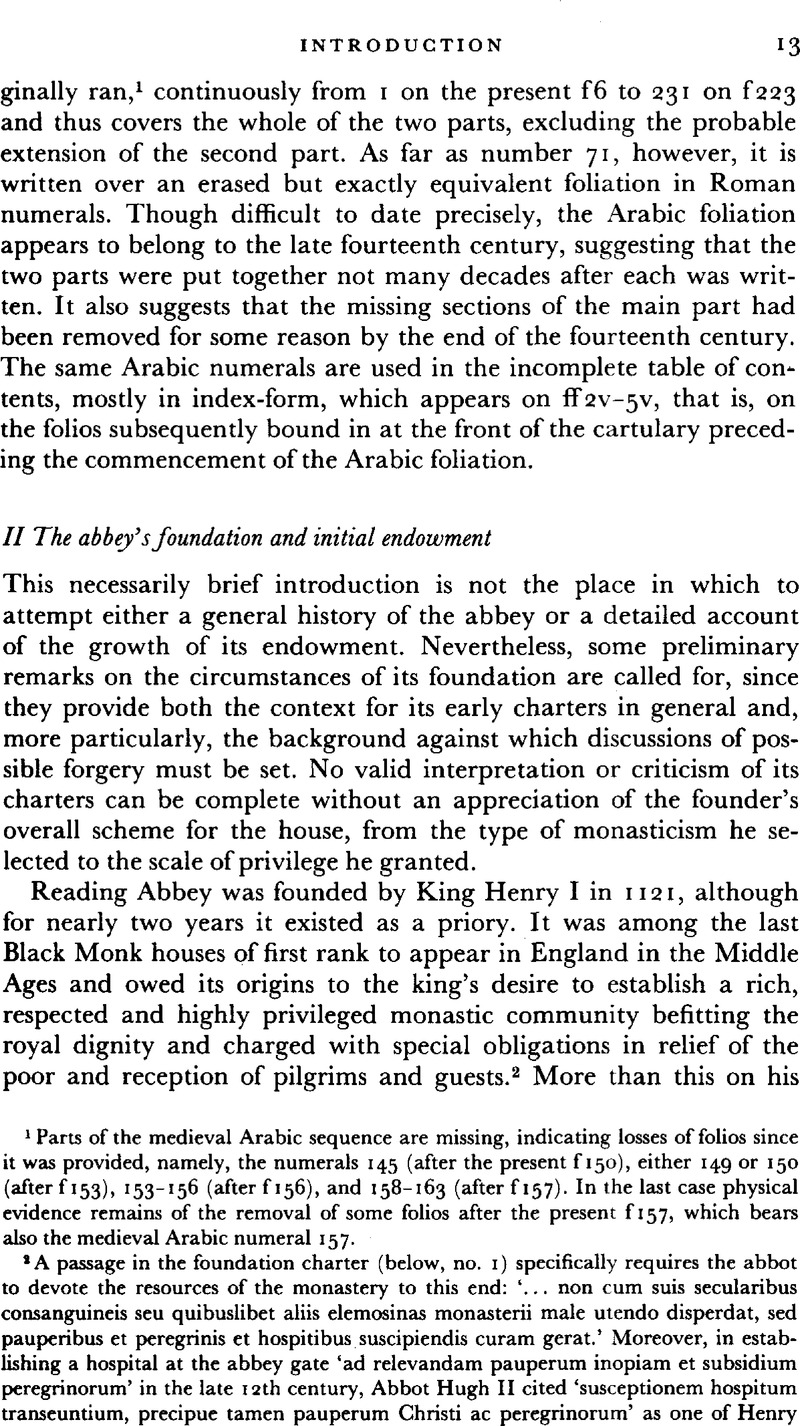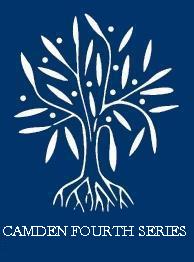No CrossRef data available.
Article contents
II The abbey's foundation and initial endowment
Published online by Cambridge University Press: 21 December 2009
Abstract

- Type
- Introduction
- Information
- Copyright
- Copyright © Royal Historical Society 1986
References
page 13 note 2 A passage in the foundation charter (below, no. 1) specifically requires the abbot to devote the resources of the monastery to this end: ‘… non cum suis secularibus consanguineis seu quibuslibet aliis elemosinas monasterii male utendo disperdat, sed pauperibus et peregrinis et hospitibus suscipiendis curam gerat.’ Moreover, in establishing a hospital at the abbey gate ‘ad relevandam pauperum inopiam et subsidium peregrinorum’ in the late 12th century, Abbot Hugh II cited ‘susceptionem hospitum transeuntium, precipue tamen pauperum Christi ac peregrinorum’ as one of Henry I's main purposes in founding the abbey (below, no. 224). See also William of Malmesbury's elaborate tribute to the hospitality of Reading in its early years (Gesta Regum, ed. W. Stubbs. (RS, 1887–1889), i. 489Google Scholar) and, for further discussion, see Leyser, K., ‘Frederick Barbarossa, Henry II and the hand of St James’, EHR xc (1975), 494–5.CrossRefGoogle Scholar
page 14 note 1 Henry died at Lyons-la-Forêt, in eastern Normandy, on 1 December 1135, having given instructions on his death-bed that his body was to be buried at Reading. It was taken first to Rouen for disembowelling and embalming, and thence to Caen where, the winds being contrary, it was lodged in St Stephen's abbey until after Christmas, when a crossing to England became possible (Orderic Vitalis, vi. 448–50; William of Malmesbury, Historia Novella, ed. K. R. Potter (1955), 12–14, 16Google Scholar; Henry of Huntingdon, Historia Anglorum, ed. T. Arnold (RS, 1879), 256–8Google Scholar; The Letters of Peter the Venerable, ed. G. Constable (Harvard, 1967), i. 22)Google Scholar. The king was buried at Reading on 5 January 1136 (‘Annales Radingenses’, 11; continuator of Florence of Worcester, in Florentii Wigorniensis … Chronicon ex Chronicis, ed. B. Thorpe (Eng. Hist. Soc., 1848–1849), ii. 95Google Scholar; ‘Winchcombe Annals’, ed. R. R. Darlington, Med. Misc. for D.M. Stenton, 127)Google Scholar. The date usually given for his burial is 4 January, which is derived from Gervase of Canterbury (Historical Works, ed. W. Stubbs (RS, 1879–1880), i. 95Google Scholar), but this is strictly the date which Gervase gives for the bringing of the body from Normandy to England.
page 14 note 2 For William I's burial at St Stephen's, Caen, see Orderic Vitalis, iv, 102–6. Stephen was buried at Faversham, where the original plan of the abbey church included what appears to have been a large royal funerary chapel occupying much of its eastern arm (Hallam, E. M., ‘The burial places of English kings’, History Today 07 1981), 46Google Scholar; Philp, B., Excavations at Faversham, 1965 (Kent Archaeol. Research Group's Council, 1968), 15–17, 37).Google Scholar
page 14 note 3 For evidence of Henry's concern that royal burials should only take place in suitably noble churches, see Hallam, E. M., ‘Royal burial and the cult of kingship in France and England, 1060–1330’, Journ. of Medieval History, viii (1982), 360.Google Scholar
page 14 note 4 For a detailed account of the wreck of the White Ship and the king's grief at his son's death, see Vitalis, Orderic, vi. 294–306Google Scholar. It is interesting in this respect that, according to the foundation charter, among the souls for whose welfare Reading Abbey was founded was that of Henry's son, William (below, no. 1).
page 14 note 5 Knowles, D., The Monastic Order in England, (2nd edn, Cambridge, 1963), 174.CrossRefGoogle Scholar
page 15 note 1 For the Cistercians, see Knowles, ibid., 175; Gallia Christiana, xi, 307–8Google Scholar (for Mortemer in Normandy, although this did not become a full member of the Order until after Henry's death). For the Austin canons, see Knowles and Hadcock, 2nd edn, 156 (for Dunstable); The Cartulary of Cirencester Abbey, ed. C.D. Ross (1964), i. 21Google Scholar; The Cartulary of the Priory of St Denys near Southampton, ed. E. O. Blake (Southampton Records Ser., 1981), i, p. xxxvGoogle Scholar; ii. 211.
page 15 note 2 ‘Annales Radingenses’, 10.Google Scholar
page 15 note 3 Ibid. The precise date is given in Flor. Hist., ii. 49Google Scholar; this work is now known certainly to be by Matthew Paris, who is presumed to have taken material from a lost chronicle of Reading (Vaughan, R., Matthew Paris (Cambridge, 1958), 37–41, 104Google Scholar), presumably that listed in the late 12th-century list of books at Reading as Gesta regis Henrici et ystoria Rading' in uno volumine (Egerton 3031, f9r; see below, no. 225).
page 15 note 4 This is clear from the tone of Peter the Venerable's carta societatis to Abbot Hugh and the convent of Reading (no. 218) and, more precisely, from the charter of La Charité cited in note 5.
page 15 note 5 Faversham was founded in 1148 (Heads of Relig. Houses, 49 n.3) and was settled by Cluniac monks from Bermondsey, a dependency of La Charité-sur-Loire. Both the abbot of Cluny and the prior and convent of La Charite granted the new abbey complete freedom from all obedience and subjection to Cluny and La Charite, the latter adding that it was to enjoy the same freedom as Reading Abbey, also settled by Cluniac monks (Saltman, , Theobald, 82–3Google Scholar; Mon. Ang., iv. 575).Google Scholar
page 16 note 1 See below, nos. 139, 1.
page 16 note 2 Hanborough church (Oxon.) was given in c. 1130 × 33 (see no. 494). No charter evidence survives for Bucklebury and Pangbourne (Berks.). Both were treated separately in Domesday Book and cannot, therefore, have come to the abbey as appurtenances of Reading: Bucklebury and one Pangbourne estate were held by the Crown, the other Pangbourne estate by Miles Crispin (VCH Berks., i. 330, 334, 355Google Scholar). In 1212 both Bucklebury and Pangbourne were said to have been given to Reading Abbey by Henry I (Fees, i. 107–8Google Scholar), but this record is not uniformly accurate regarding other royal gifts to Reading. The monks' possession of Bucklebury can certainly be traced back to 1169 (PR 75Google ScholarHenry II, 80Google Scholar) and probably to 1151 × 54, when they obtained the church by exchange from St Albans Abbey (see no. 688). They had demesne in Pangbourne by 1158 × 65 (BL Cotton Vesp. E v, f 19) and, according to a diocesan confirmation of 1193, had held the church since the time of Roger bishop of Salisbury (see no. 204). Great uncertainty surrounds the history of the two Domesday estates in Pangbourne in the twelfth century, but since no lord of Pangbourne other than Reading Abbey is mentioned after that time, they must both have come to the monks. The Crown's holding could well have been given by Henry I, while Miles Crispin's holding may have been detached from his other estates, which became the Honour of Wallingford, when they were in the control of his widow's second husband, Brian fitz Count, a protégé of Henry I (Sanders, , English Baronies, 93Google Scholar); against this, however, a Richer of Pangbourne was listed among the knights of the Honour of Wallingford in 1166 (Red Bk. Exch., i. 310).Google Scholar
page 16 note 3 All were Anglo-Saxon houses, Reading and Leominster being nunneries, whose lands were held by the Crown in 1086. See Knowles and Hadcock, 2nd edn, 62, 69, 74. For Leominster, see also Kemp, B. R., ‘The monastic dean of Leominster’, EHR, lxxxiii (1968), 505–6.CrossRefGoogle Scholar
page 17 note 1 Battle was first given Funtington, which was very soon exchanged for Appledram, both in Sussex (The Chronicle of Battle Abbey, ed. Searle, E. (Oxford, 1980), 122)Google Scholar; Tutbury received the unidentified Brincheale (see below, no. 18 n.1); and Mont St Michel was given £12 worth of land at Budleigh (Devon) in exchange for the churches of Cholsey and Wargrave (see nos. 3, 771).
page 17 note 2 See no. 1108.
page 17 note 3 See above, n. 1.
page 17 note 4 The later manors of Tilehurst, etc., are not mentioned in Domesday Book, but all appear in the abbey's possession in the twelfth century—Tilehurst by 1130 × 35 (see nos. 1132–9, etc.), Beenham by 1158 × 65 (BL Cotton Vesp. E v, f19), and Sulhamstead Abbots by 1173 (see no. 1075)—and presumably formed parts of the 43 hides which made up Reading in 1086 (VCH Berks., i. 334Google Scholar). By virtue of its possession of the ancient minster church of St Mary in Reading, from which Minster Street in the town was named, the abbey acquired not only the younger churches in the lands of Reading but also the right to receive pensions from other churches formerly payable to St Mary's (see nos. 179, 797–9).
page 17 note 5 For the manor and members of Leominster in Domesday Book, see VCH Herefs., i. 314Google Scholar; an analysis of the charters in the Leominster cartulary (BL Cotton Domit. A iii) reveals that at least ten of the sixteen members which had belonged to Leominster in 1066 came with the caput into Reading's possession. For the church of Leominster and its parochia, see below, no. 354.
page 17 note 6 See Kemp, , ‘The monastic dean of Leominster’, 512–13Google Scholar, citing ‘Annales Radingenses’, 11. Henry's brother-in-law, King David I of Scotland, endowed Reading Abbey with possessions in Scotland which enabled a second dependent priory to be founded on the Isle of May (see below, no. 1276 n., and Cowan, I.B. and Easson, D. E., Medieval Religious Houses, Scotland (2nd edn, 1976), 59–60).Google Scholar
page 18 note 1 No. 2.
page 18 note 2 See no. 1 n.3.
page 18 note 3 For these provisions, see the foundation charter (no. 1).
page 19 note 1 The late 12th-century list of relics is preserved in Egerton 3031, ff 6v–8r (see below, no. 227). For a valuable discussion, see Bethell, D., ‘The making of a twelfth-century relic collection’, Studies in Church History, viii (1971), 61–72Google Scholar. Bethell discerned several different elements in the collection, including Anglo-Saxon, Cluniac, Byzantine and Holy Land groups. For Henry I's certain or probable involvement in the acquisition of particular relics, see ibid., 69.
page 19 note 2 See no. 5 and n.


